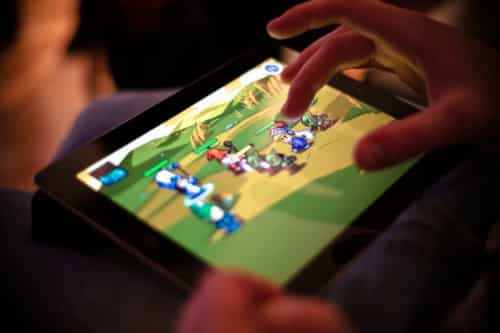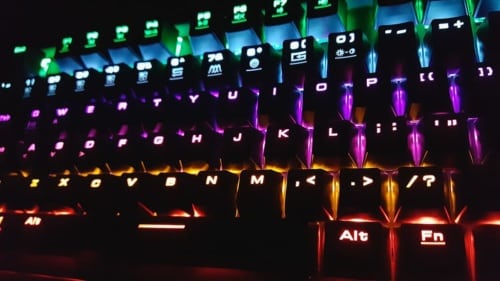Rethinking Literacy, Learning, and Student Success
By Michele Haiken
155 million Americans play video games. 42 percent of Americans play video games regularly – three or more hours a week. – ESA, 2015
Many of our students are among the 155 million Americans playing video games regularly, as you might be, too.
When my students are playing video games, they are using many skills – facts and information are tools to solve problems in context. Failure is a source of feedback and learning, collaboration is necessary, and learning and assessment are tightly integrated. Gamification is not worksheets for points; facts and information are used as tools for learning and assessment. Effective games are customized to different learners and students are encouraged to take risks and seek alternative solutions. In classrooms today, it’s not only about learning content material. Students must experience and build the necessary skills to be creators, innovators, and problem solvers in order to develop critical thinking and improve academic achievement.
How can teachers use this pervasive and engaging gaming phenomenon to redesign and supercharge the learning experience?
 Gamification is about transforming the classroom environment and literacy instruction into a game. It requires creativity, collaboration and play. There are numerous ways to bring games and game playing into the English Language Arts classroom to promote learning and deepen student understanding. Whether teachers are looking to bring in some aspect of gaming into their class or use a game platform across the curriculum, they can bring in elements of gamification to enhance learning and student engagement, tap into Common Core State Standards and meet ISTE Standards.
Gamification is about transforming the classroom environment and literacy instruction into a game. It requires creativity, collaboration and play. There are numerous ways to bring games and game playing into the English Language Arts classroom to promote learning and deepen student understanding. Whether teachers are looking to bring in some aspect of gaming into their class or use a game platform across the curriculum, they can bring in elements of gamification to enhance learning and student engagement, tap into Common Core State Standards and meet ISTE Standards.
Here are four ways to gamify your English Language Arts class to boost engagement, collaboration, literacy, and learning:
1.) Adapt old school games for classroom use. Scavenger hunts, Bingo, Roll the Dice, Connect Four and Scrabble are all games that have been around for decades and can be adapted for classroom learning. Put vocabulary words or comprehension questions on a Bingo card and see how many students are able to get Bingo. Working in groups, students can play Scrabble and spell out answers to content-specific questions. Design a Snakes & Ladders game around one of Shakespeare’s plays or Heads Up based on symbols and characters in a classic novel like To Kill a Mockingbird.
2.) Play digital games. Students love playing Kahoot!, Quizizz and Quizlet Live. These free gaming platforms allow teachers to create multiple-choice questions while players answer on their own devices. Teachers can also choose from the thousands of games already shared on these game sites or create content-specific questions to use as pre-assessments, quizzes or exit tickets. A digital game can also be used as a jumping off point to a larger quest or classroom game.
 3.) Create a quest. A quest is a mission with an objective. Every year my students participate in a Current Events Adventure Quest, a trivia game based on the weekly current events reading. Students who answer a specific text-dependent question correctly earn points. The student with the most points after six weeks wins a prize. Additional questions are posted on Remind and Twitter based on news of the day for additional points. Quests can also be independent projects or activities for the students who go above and beyond. Using the app Goose Chase, create digital scavenger hunts sending students off to take pictures, create a video, or search an answer online related to a specific topic.
3.) Create a quest. A quest is a mission with an objective. Every year my students participate in a Current Events Adventure Quest, a trivia game based on the weekly current events reading. Students who answer a specific text-dependent question correctly earn points. The student with the most points after six weeks wins a prize. Additional questions are posted on Remind and Twitter based on news of the day for additional points. Quests can also be independent projects or activities for the students who go above and beyond. Using the app Goose Chase, create digital scavenger hunts sending students off to take pictures, create a video, or search an answer online related to a specific topic.
4.) Earn a badge for mastery. Think about what the Girl Scouts and Boy Scouts have been doing all along, recognizing mastery and achievement with badges. Teachers can do the same by recognizing student accomplishments and mastery with badges. When my students are working in book clubs, they are working on earning badges to show their reading and understanding of the text. Students work toward completing different badges to show mastery of a concept, standard or skill. Badges can be presented digitally using Classbadges or can be displayed for all to see once students have earned a specific badge.
 One student recently told me that gaming in English was a fun learning alternative which has made her a stronger English student. She went on to say that striving for game points throughout the school year strengthened her work ethic and improved her writing and reading skills, which overall improved her grade. As a teacher, gamification has allowed me to coach students to be successful readers, writers, and critical thinkers. Students learn through play, collaboration, and quest-based adventures. Gamification is an approach to learning that connects meaningful gaming with content objectives to re-engage students and boost learning.
One student recently told me that gaming in English was a fun learning alternative which has made her a stronger English student. She went on to say that striving for game points throughout the school year strengthened her work ethic and improved her writing and reading skills, which overall improved her grade. As a teacher, gamification has allowed me to coach students to be successful readers, writers, and critical thinkers. Students learn through play, collaboration, and quest-based adventures. Gamification is an approach to learning that connects meaningful gaming with content objectives to re-engage students and boost learning.
Author
Further Reading
- The Washington Post – The untapped lessons hidden in computer games
- edCircuit – No More Hand-Me-Down Tech: Developing K-8 Learning Interfaces for Schools
- Nibletz – Filament Games Is Bridging Important Gaps In The Classroom


